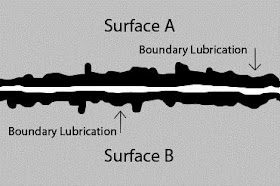What impact does the lubrication system have on oil selection?
Who cares what lubrication system you use? Surely this can’t have a major impact on the choice of a lubricant? We’ve spent a lot of time talking about oils, their viscosity and their makeup but we haven’t really looked at the lubrication system and it’s impact on the choice of lubricant and additive package.I came across this illuminating article in "Bob’s the oil guy”, that examines the lubrication system.
The Lubrication System
The design of oil is to produce a film of oil between two mating surfaces which gives you the best protection against wear. As the image below shows, oil flows, and creates a hydraulic pressure (elastohydrodynamic lubrication, or EHL) between the two surfaces. Now under perfect conditions this type of lubrication system will not allow wear. But in reality, this is not always the case.This takes us to the next state of lubrication.
The Mixed Film Lubrication System
This is where lubrication is marginal. Under load conditions oil is squeezed under pressure. For example, during acceleration of an engine, you step on the gas and the engine dumps fuel, in turn the force is increased against the rod bearings, pushing (or squeezing) on the hydrodynamic oil creating a marginal lubrication condition. This is under normal use. But what happens to oil when it is under extreme pressure created by abuse or just a heavy foot? Obviously the film is compromised and that’s why a motor oil Viscosity index modifier is often blended into the package.The Boundary Lubrication System
Boundary lubrication is dependent on antiwear additives. What happens here, is lubrication can be put under so much pressure, and is momentarily squeezed out to such a point that if oil didn’t have any antiwear additives, you would be metal to metal. This is the last line of defense for lubrication to protect your equipment.A common place where you see a lot of high levels of barrier lubricant is in gear lubes. Ever wonder what that rotten smell was? Yep, high levels of zinc, and phosphorus. These are the two most used antiwear wear additives used in oils today. A lot of aftermarket additives use zinc and phosphorus for extra protection. The problem is, when you overload an oil with this type of additive, your oxidation levels tend to increase, causing an attack on the base oil, which in turn can cause an increase of viscosity, (thicken the oil) .
This is why it is important not to play home chemist and blend in aftermarket additives that are not designed to be in the oil to start with.
So, as you can see, viscosity of the oil isn’t the only important factor. Like building a house, you want a good foundation or base. Then you would use a quality product to perform with the particular lubrication system.
Read more: http://www.bobistheoilguy.com/states-of-lubrication/
As a consumer you focus more on the application than the lubrication system, but it’s handy to know what demands are placed on oils. If your application is severe, one way of increasing the safety margin is often to opt for synthetic oil.
At Habot synthetic lubricants we have a wealth of skill and experience in what stresses a specific lubrication system places on the lubricant and as such are well qualified to offer you one of our quality products.



No comments:
Post a Comment